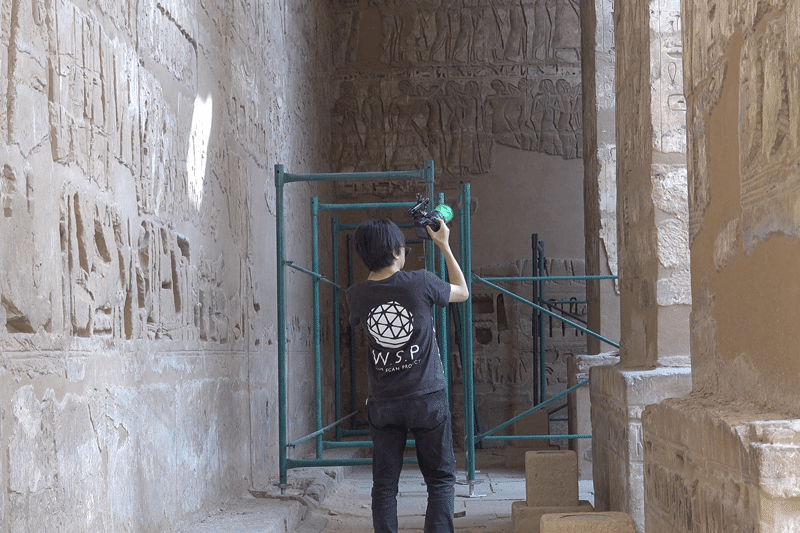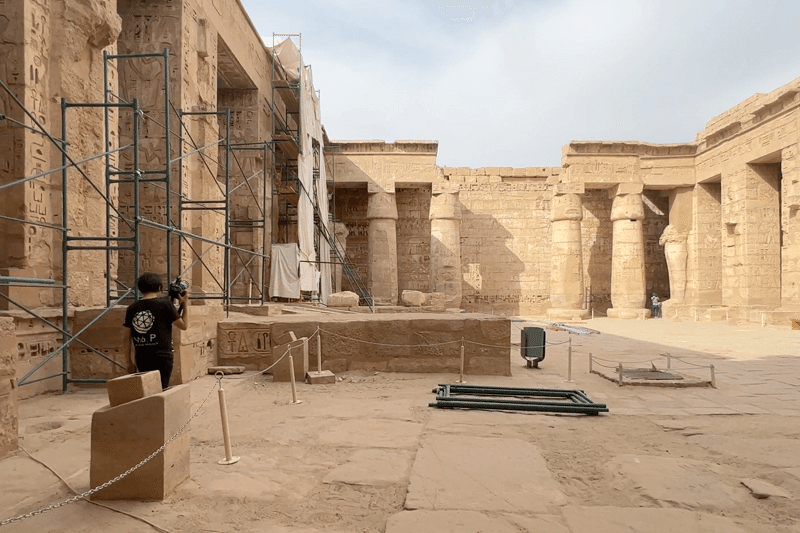
Mortuary Temple of Ramesses III 3D Scanning Project - WORLD SCAN PROJECT’s Challenge
Luxor, located on the west bank of the Nile, is an area rich in monuments symbolizing death, such as the Valley of the Kings and the Mortuary Temple of Hatshepsut, due to its location in the direction of the setting sun.
Among them, the Mortuary Temple of Ramesses III, which was surveyed using 3D scanning by the World Scan Project (W.S.P.), stands out as a significant heritage site that conveys the great achievements of Ramesses III through its magnificent structure and vivid records of his battles.

Photo by Diego Delso via Wikimedia Commons (CC BY-SA 4.0 DEED)
The Last Great Pharaoh of the New Kingdom: Ramesses III
When Ramesses III ascended to the throne as the second pharaoh of the 20th Dynasty, Egypt was exposed to attacks by Libyans and other foreign tribes known as the "Sea Peoples," and was plagued by a decline in national strength due to economic problems. To counter these threats, Ramesses III led numerous military campaigns to defend Egypt from foreign invaders, earning him the reputation of being the "last great pharaoh of the New Kingdom."
The Mortuary Temple (Medinet Habu) records his battles, with the massive gate depicting Ramesses III grasping his enemies, striking them down, and offering them to Amun-Ra, the chief deity of Luxor. In addition, the names of conquered lands are inscribed at the base of the reliefs, praising his achievements in restoring order and subduing chaos.

Luxor (Egypt): the first pylon of Ramses III temple at Medinet Habu
Photo by Marc Ryckaert via Wikimedia Commons (CC BY-SA 4.0 DEED)


The Battles between Ramesses III and the " Sea Peoples"
Among the many wars Ramesses III waged, the most famous is his battle against the Sea Peoples in the eighth year of his reign. The "Sea Peoples" were a coalition of various foreign tribes, including the Philistines and the Sherden, who attempted to invade and settle in the fertile lands of Egypt. However, Ramesses III's forces repelled their invasion and also thwarted their attempts to land via the waterways.
The intense battle scenes are depicted on the northern wall of the gateway, showing enemy ships and the advancing Egyptian army. At the feet of Ramesses III, who is depicted aiming his arrows at the enemy, lie the bodies of the defeated, illustrating his bravery.


Earlier Historical Records of Ramses III
The Epigraphic Survey, University of Chicago
The Courtyard with Various Reliefs
The first peristyle courtyard features Osiris columns and graphic depictions on the walls of prisoners with their wrists bound. In addition, wrestling-like combat sports were held in the courtyard, and the winners were rewarded by the king. There are also murals depicting scenes of lifting opponents and putting them in a full nelson.

Luxor (Egypt): first courtyard of Ramses III temple at Medinet Habu
Photo by Marc Ryckaert via Wikimedia Commons (CC BY-SA 4.0 DEED)


In the second courtyard, there are beautiful reliefs of the "Festival of Sokar," which honors the god of the underworld, and the "Festival of Min," dedicated to the god of fertility. The god Min is depicted with an erect penis, and offerings of lettuce were brought to him. This is believed to be because the milky white fluid that oozes from a freshly cut lettuce stem was equated with semen.

second courtyard of Ramses III temple at Medinet Habu
Photo by Marc Ryckaert via Wikimedia Commons (CC BY-SA 4.0 DEED)


Festival Scenes of Ramses III
The Epigraphic Survey, University of Chicago
The ceiling of the hypostyle hall retains a clear blue decoration, a rarity among ancient ruins in such beautiful preservation. This makes it an extremely valuable resource for understanding the color sense of the ancient Egyptians. For example, blue, often used in these decorations, symbolizes the sky and water, representing sacredness and eternity. Each color, carefully applied to the detailed decorations of the mortuary temple, carries deep religious significance.

Medinet Habu - Temple of Ramesses III , Luxor, 3 Jan 2011
Photo by anagh via Wikimedia Commons (CC BY-SA 3.0 DEED)
The Sanctuary of Ramesses III's Mortuary Temple
The innermost sanctuary was originally built to be dimly lit, but due to extensive damage, the roof, including that of the hypostyle hall, has completely disappeared. However, the massive stone columns and carvings retain traces of their original grandeur, suggesting that the space was once magnificent.

seen from the second hypostyle hall
Photo by Marc Ryckaert via Wikimedia Commons (CC BY-SA 4.0 DEED)
Bringing the World, the Future, and Curiosity Closer
The World Scan Project, conducted 3D scanning of the reliefs and structures inside the Mortuary Temple of Ramesses III, which contains records of wars, to preserve it as digital data. The task of obtaining detailed data without physically touching the ruins was extremely challenging, but thanks to the cooperation of the entire team, we completed it.

The data obtained through this project will be transformed into VR and the metaverse, making it accessible not only to researchers but also to people around the world. This will allow many to appreciate the beauty and historical value of the Mortuary Temple of Ramesses III and raise awareness for its preservation.
The World Scan Project will continue its efforts to protect and pass on valuable heritage to future generations. If you are interested in our activities, please follow and support us.

Please also check out this video about the Mortuary Temple of Ramesses III.
この記事が気に入ったらサポートをしてみませんか?
